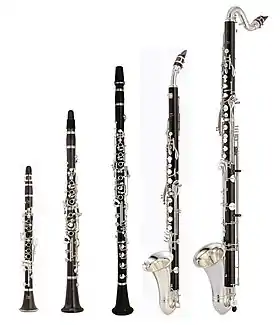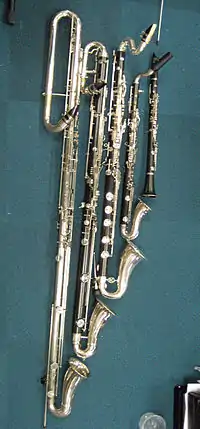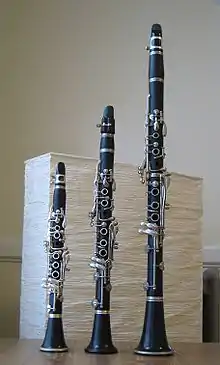Clarinet family
The clarinet family is a musical instrument family including the well-known B♭ clarinet, the bass clarinet, the slightly less familiar E♭ and A clarinets and other clarinets.

A group of commonly used clarinets. In order from left to right: E♭ soprano, B♭ soprano, basset clarinet in A, E♭ alto, B♭ bass

In order from left to right: BB♭ contrabass, EE♭ contra-alto, B♭ bass, E♭ alto, B♭ soprano

Size comparison among the A♭, E♭, and B♭ clarinets
Clarinets other than the standard B♭ and A clarinets are sometimes known as harmony clarinets. However, there are many differently-pitched clarinet types, some of which are very rare. They may be grouped into sub-families, but grouping and terminology vary; the list below reflects popular usage and compares it with systems advocated by a few influential authors. See separate articles for additional details.
- Octave clarinets — Very rare. Pitched around an octave higher than the B♭ clarinet.
- A♭ piccolo clarinet.
- Rendall uses the term octave clarinet and includes also obsolete instruments in C, B♭, and G.[1]
- Shackleton lists also rare instruments in C, B♭, and A.[2]
- A♭ piccolo clarinet.
- Soprano clarinet — The most familiar type of clarinet. Referred to as the alto in Commonwealth countries such as Canada.
- E♭ clarinet/E♭ sopranino clarinet — Fairly common in the United States and western Europe; less common in eastern Europe. Referred to as the soprano in Commonwealth countries. Resurgence in popularity due to the high-quality production in China.
- D clarinet — Rare in the United States and western Europe. Required in Molter's very early clarinet concertos.
- Rendall lists the E♭ and D clarinets, along with obsolete instruments in G, F, and E, as sopranino clarinets.
- Shackleton lists the E♭ and D clarinets, along with obsolete instruments in F, and E, as sopranino clarinets.
- The E♭ and D clarinets are commonly called piccolo clarinets in eastern Europe and Russia.
- C clarinet — This instrument became practically obsolete in the orchestras of Europe and the United States in the early twentieth century. The inclusion of the C clarinet, however was not unusual in orchestral scores from the era of Haydn and Mozart right through to the early 20th century. Mahler certainly included them up until his fourth symphony. Much of the orchestral repertoire of Beethoven and Schubert requires the C clarinet. This being the case, the nineteenth century clarinetists were faced with the difficult task of maintaining and alternating between instruments in A, B♭ and C. Since this was not always necessary or desirable for a first rate clarinetist, who could transpose easily between instruments and may not have wished to change from a warm to a cold instrument, the tendency has been to reduce, with the result that the usage of the C clarinet has gradually declined from the standard classical orchestra.
- Recently, however, the C clarinet is enjoying a resurgence, as there is now a renewed interest in playing older works on their authentic instruments. This applies to orchestral music and also to popular folk styles such as klezmer music. At the same time there has been an innovation in Britain to use a simplified cheaper version of the C clarinet, so called clarinéo,[3] as the principal wind instrument for young learners, a position until recently, occupied by the recorder.
- The clarinet in C is sometimes called for in clarinet choirs, often as a substitute for the oboe. This clarinet has been made more common and inexpensive due to the manufacturing of clarinets of all sizes in China.
- B♭ clarinet — The most common type of clarinet.
- A clarinet — Standard orchestral instrument used alongside the B♭ soprano. It is required primarily in older, European classical music. Every serious classical clarinetist will own both a B♭ and an A clarinet, and cases holding both instruments are common. The A clarinet is not used in band music.
- G clarinet — Also called a "Turkish clarinet". Primarily used in certain ethnic music. This type of clarinet is rare but regaining popularity as production increases in Chinese factories. The “Turkish” G clarinet primarily and traditionally uses Albert System keywork, but there has been a demand for a Boehm system G clarinet. Chinese mass production of clarinets in G has brought a slow resurgence to this rare clarinet. Factories in Asia and primarily China have now been mass producing G clarinets in Boehm system, filling the need for western players.
- Rendall lists the C, B♭, and A clarinets along with the obsolete instrument in B as sopranos, and the clarinette d'amour in A♭ and G and the clarinet in G as obsolete altos.
- Shackleton lists the C, B♭, A, and G clarinets along with obsolete instruments in B and A♭ as sopranos, noting that the A♭ and G often occurred as clarinette d'amour in the mid-18th century.
- Rice classifies G clarinets with flared bells as altos, with pear- or bulb-shaped bells as clarinets d'amour.[4]
- Basset clarinet — Essentially a soprano clarinet with a range extension to low C (written).
- A basset clarinet — Most common type.
- Basset clarinets in C, B♭, and G also exist.
- Rendall includes no basset clarinets in his classifications. Shackleton has three in his collection: Numbers 5389 (B♭ and A set) and 5393 (in A). See Catalogue of the Sir Nicholas Shackleton Collection, Edinburgh University Collection.
- Basset horn — Alto-to-tenor range instrument with (usually) a smaller bore than the alto clarinet, and a range extended to low (written) C.
- Alto clarinet — Pitched a perfect fifth (or, rarely, a perfect fourth) lower than the B♭ soprano clarinet.
- E♭ alto clarinet — Most common type. Range usually down to low E♭ (written). Referred to as the tenor in Commonwealth countries.
- Rendall lists the E♭ alto and F tenor clarinets as tenors (along with the basset horns).
- Shackleton lists the F alto clarinet as obsolete.
- E♭ alto clarinet — Most common type. Range usually down to low E♭ (written). Referred to as the tenor in Commonwealth countries.
- Bass clarinet — An octave below the B♭ clarinet often with an extended low range.
- B♭ bass clarinet — The standard bass. Common variants extend to either low C or low E♭.
- “A” bass clarinet — Very rare today, more common around 1900. Nineteen examples have survived, seven of which are playable[7]
- C bass clarinet — Obsolete.
Few examples have survived in playable condition.
- Rendall and Shackleton list C, B♭, and A; Rendall lists only C as obsolete, while Shackleton calls A "rare". Rendall groups these in baritone and bass.
- Contra-alto clarinet — An octave below the alto clarinet.
- EE♭ contra-alto clarinet, also called EE♭ contrabass clarinet.
- Rendall lists "contrabasset-horns" in G, F, and E♭ (none marked obsolete), grouping these in baritone and bass.
- Shackleton lists only "E♭ contrabass clarinet", grouping it in contrabass (pedal) clarinets.
- EE♭ contra-alto clarinet, also called EE♭ contrabass clarinet.
- Contrabass clarinet — An octave below the bass clarinet.
- BB♭ contrabass clarinet. Common in the 20th century, getting rarer now.
- Rendall lists also contrabass clarinet in C as obsolete, and groups it and the BB♭ contrabass in baritone and bass.
- Shackleton lists only the BB♭ contrabass, grouping it in contrabass (pedal) clarinets
- BB♭ contrabass clarinet. Common in the 20th century, getting rarer now.
- Two larger types have been built on an experimental basis:
- EEE♭ octocontra-alto — An octave below the contra-alto clarinet. Only one was ever built.
- BBB♭ octocontrabass — An octave below the contrabass clarinet. Only one was ever built.
- Neither Rendall nor Shackleton includes these in their classifications.
The most common clarinets
- Except for the A clarinet and the uncommon A♭ sopranino instrument, the clarinets in standard repertoire are pitched in B♭ or the related E♭. Except for the saxophone, the other commonly-used woodwind instruments (flute, oboe, English horn, bassoon) are in C (the English horn in F). However, B♭ instruments are commonly found in the brass family.
- There are more B♭ clarinets in the world than all other types of clarinets combined. It is the "default" or generic clarinet. Every student begins on a B♭ instrument.
- Next in popularity is the A clarinet. Every professional clarinetist playing classical music has one.
- Somewhat less common is the B♭ bass clarinet (older than the alto clarinet). Since about the middle of the 19th century, it has been treated by orchestral composers as an optional supplementary instrument to the standard B♭ soprano or treble clarinet. In music since 1950 it has been used as more of a standard or core instrument in band or wind ensemble music.
- Less common still are the E♭ alto and soprano clarinets. The alto is seen less in classical music than the B♭ bass. It is used most often in band or wind ensemble music.
- Still less common are the C clarinet (not used in recent compositions) and the A♭ sopranino. The EE♭ contra-alto and BB♭ contrabass clarinets are seen very infrequently. All other varieties of clarinets are only used in older music (pre-20th century).
References
- F. Geoffrey Rendall. The Clarinet. Third Edition. London: Ernest Benn Limited, 1971, pp. 3-4.
- Nicholas Shackleton. "Clarinet", Grove Music Online, ed. L. Macy (accessed 21 February 2006), grovemusic.com (subscription access).
- Origins of the Clarinéo, http://www.clarineo.co.uk/origins.asp
- Albert R. Rice. From the Clarinet D'Amour to the Contra Bass: A History of Large Size Clarinets, 1740-1860. Oxford University Press, 2009, pp. 9-10.
- Lawson, Colin (Nov 1987). "The Basset Clarinet Revived". Early Music. 15 (4): 487–501. doi:10.1093/earlyj/XV.4.487.
- Rice, Albert R. (Sep 1986). "The Clarinette d'Amour and Basset Horn". Galpin Society Journal. The Galpin Society Journal, Vol. 39. 39: 97–111. doi:10.2307/842136. JSTOR 842136.
- Bowen, D. Keith (September 2009). "The Rise and Fall of the Bass Clarinet in A". Dissertation, Open University UK.
This article is issued from Wikipedia. The text is licensed under Creative Commons - Attribution - Sharealike. Additional terms may apply for the media files.
